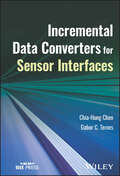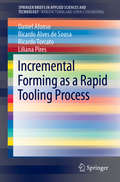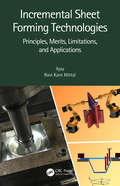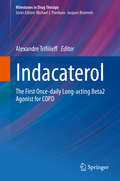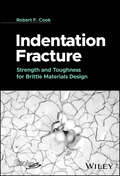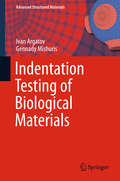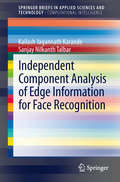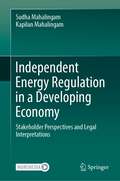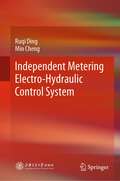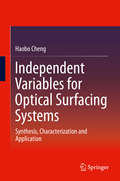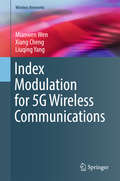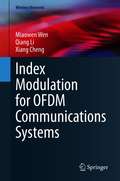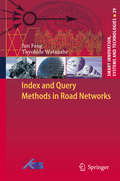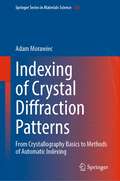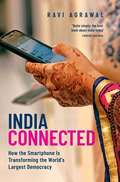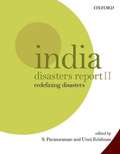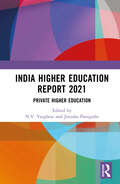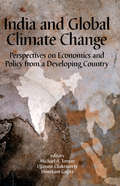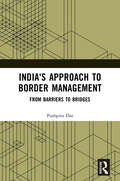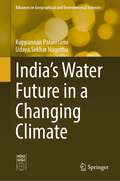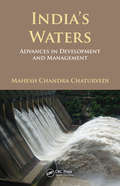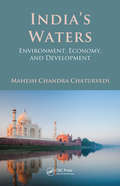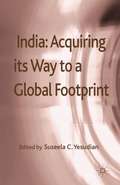- Table View
- List View
Incredible LEGO Technic: Cars, Trucks, Robots & More!
by Pawel Sariel KmiecFrom tanks to tow trucks, all the models showcased in this book use LEGO Technic gears, pulleys, pneumatics, and electric motors to really move. You’ll find some of the world’s best fan-created LEGO supercars, construction equipment, monster trucks, watercraft, and more, along with design notes and breakaway views of the truly incredible mechanisms inside.Look closely, and you’ll learn how expert builders use differentials, suspensions, linkages, and complex gearing systems in their creations.Whether you’re a beginning builder or a longtime LEGO fan, Incredible LEGO Technic offers a unique look at the artistry and engineering that can make your LEGO creations come alive.
Incremental Data Converters for Sensor Interfaces
by Gabor C. Temes Chia-Hung ChenComprehensive resource discussing operating principles, available architectures, and design of micropower incremental analog-to-digital converters (IADCs) Incremental Data Converters for Sensor Interfaces describes the motivation for using incremental analog-to-digital converters (IADCs), including the theoretical foundations of their operation, the trade-offs in their use, and the practical issues in the circuit analysis and design of IADCs. The text covers core foundational knowledge such as the key algorithms used, circuits for single-stage and multi-stage IADCs, the design of the digital post filters for single- and multi-stage IADCs, IADC applications in measurement and instrumentation, medicine, imagers, and IoT, and comparison of delta-sigma (D-S) and incremental ADCs (IADCs) in terms of accuracy, latency, and multiplexed operation. To aid in reader comprehension and serve as an excellent classroom learning resource, Incremental Data Converters for Sensor Interfaces includes in-text problems and homework for graduate studies, along with helpful computer codes in MATLAB and Simulink. Additional topics covered in Incremental Data Converters for Sensor Interfaces include: Sensors and sensor interfaces, mixed-mode (analog–digital) communication and consumer signal chains, and ADC algorithms Quantization errors vs. quantization noise, and performance parameters and figures of merit, including resolution, linearity, accuracy, bandwidth, latency, and power dissipation Nyquist-rate and oversampling data converters, noise-shaping ADCs, and basic architectures for IADCs, including single- and multi-stage designs and discrete vs. continuous-time operation Loop filter design, D/A converter design, dynamic element matching and digital calibration, and quantizer design With comprehensive coverage of foundational knowledge surrounding the subject, various real-world examples, and helpful learning aids, Incremental Data Converters for Sensor Interfaces is an essential resource for graduate students in electronics programs, along with industrial circuit design professionals.
Incremental Forming as a Rapid Tooling Process (SpringerBriefs in Applied Sciences and Technology)
by Daniel Afonso Ricardo Torcato Liliana Pires Ricardo Alves de SousaThis book discusses the general concept and applications of rapid tooling technologies and introduces the use of incremental forming for the development of rapid sheet tools. Methods and techniques for tool design and development are discussed, considering their manufacture using incremental forming and complementary processes. The mechanical and thermal performance of sheet metal tools is analyzed. Finally, possible applications are introduced, with the description of some case study examples.
Incremental Sheet Forming Technologies: Principles, Merits, Limitations, and Applications
by Ajay Ravi Kant MittalIncremental Sheet Forming (ISF) exempts use of dies and reduces cost for manufacturing complex parts. Sheet metal forming is used for producing high-quality components in automotive, aerospace, and medical industries. This book covers the benefits of this new technology, including the process parameters along with various techniques. Each variant of this novel process is discussed along with the requirements of machinery and hardware. In addition, appropriate guidelines are also suggested regarding the relationship between process parameters and aspects of ISF process in order to ensure the applicability of the process on the industrial scale. This book will be a useful asset for researchers, engineers in manufacturing industries, and postgraduate level courses.
Indacaterol
by Alexandre TrifilieffChronic obstructive pulmonary disease (COPD) is a multi-component condition that results in increasingly limited airflow, usually associated with an abnormal inflammatory response of the lung. It constitutes a major public health burden worldwide, while only very few effective therapies are available. This book provides a comprehensive overview of the development of Onbrez Breezhaler, a newly approved once-daily inhaled β2 agonist for the treatment of COPD. It reviews the current pharmacotherapy for COPD and discusses topics such as the chemical design and the pre-clinical pharmacology of the molecule, the early clinical development, the INHANCE study (which provides a successful example of the use of an adaptive design in the confirmatory setting) and the Phase III clinical efficacy study, as well as the history and performance of the Breezhaler device. Finally, a list of emerging targets is included that could well offer future treatment options for COPD.
Indentation Fracture: Strength and Toughness for Brittle Materials Design
by Robert F. CookA comprehensive reference with demonstrations of advanced indentation fracture techniques in practical applications to enable better design and more efficient manufacturing Indentation Fracture describes and illustrates advanced applications of indentation fracture in evaluating strength, toughness, and related properties of brittle materials. The book enables better design, manufacture, performance, and reliability of brittle materials as elements in structural components. Emphasizing the practical applications of indentation fracture techniques, especially those of indentation-strength, the book builds on a development of indentation fracture mechanics to demonstrate clear quantitative comparisons and rankings of material fracture behavior, including the behavior of toughened materials. The book includes several case studies linking indentation fracture analyses and measurements to other phenomena including fragmentation cracking, edge chipping and dicing damage, scratching and the Mohs scale, and semiconductor grinding damage. Each case study highlights a different aspect of controlled flaw fracture measurements. The book enables readers to increase the utilization of glasses, ceramics, semiconductors, and similar brittle materials in load-bearing applications by demonstrating experimental indentation techniques to better characterize fracture. A primary focus of the book is demonstration of controlled flaw indentation-strength measurements. Written by an independent scientist with significant research contributions to the field, Indentation Fracture explores a range of topics including: Brittle fracture fundamentals, discussing equilibrium fractures on uniform and localized loading leading to the Griffith and Roesler equationsIndentation strength variation, covering the effects of contact angle, spherical and flat punch contacts, and contacts in stressed and layered componentsToughened materials strength observations in alumina, silicon nitride, glass ceramics, ferroelastics, and zirconiaStrengths of silicon devices determined by wafer backgrinding, covering linear flaws in silicon, including single and multiple scratches, as well as linear, general, controlled, and grinding flaws Indentation Fracture is an essential reference on the subject for engineers across disciplines, nanotechnologists, geophysicists, and environmental scientists, along with graduate students in materials science and related programs of study.
Indentation Testing of Biological Materials (Advanced Structured Materials #91)
by Gennady Mishuris Ivan ArgatovThis book presents a comprehensive and unifying approach to analytical identification of material properties of biological materials. Focusing on depth-sensing indentation testing, pipette aspiration testing, and torsion of soft tissues, it discusses the following important aspects in detail: damping, adhesion, thickness effect, substrate effect, elastic inhomogeneity effect, and biphasic effect. This book is intended for advanced undergraduate and graduate students, researchers in the area of biomechanics as well as for biomedical engineers interested in contact problems and involved in inverse materials parameters prediction analysis.
Independent Component Analysis of Edge Information for Face Recognition
by Sanjay Talbar Kailash Jagannath KarandeThe book presents research work on face recognition using edge information as features for face recognition with ICA algorithms. The independent components are extracted from edge information. These independent components are used with classifiers to match the facial images for recognition purpose. In their study, authors have explored Canny and LOG edge detectors as standard edge detection methods. Oriented Laplacian of Gaussian (OLOG) method is explored to extract the edge information with different orientations of Laplacian pyramid. Multiscale wavelet model for edge detection is also proposed to extract edge information. The book provides insights for advance research work in the area of image processing and biometrics.
Independent Energy Regulation in a Developing Economy: Stakeholder Perspectives and Legal Interpretations
by Sudha Mahalingam Kapilan MahalingamThis book is an introduction to the challenges of independent regulation, a new governance institution introduced in developing economies in the wake of liberalization, to perform the role of a surrogate for competitive markets. It examines, in the Indian context, regulatory interpretation of key provisions of energy laws and regulatory statutes, as manifest in the adjudicatory orders of India’s petroleum and electricity regulators. The objective is to assess regulatory interpretations for consistency with the stated objectives of independent regulation. Comparing regulatory interpretation of energy laws with those of the higher judiciary, this study highlights the divergent perspectives of regulators and the higher judiciary on the role of independent regulation in a liberalized economy. In the process, this research attempts to gauge, not only the extent of regulatory expertise and independence in India’s energy space, but crucially, the Indian government's commitment to independence of regulators. The book also offers a glimpse of the operation of checks and balances in a relatively new institution situated outside the scope of the conventional Madisonian framework. Framed against the backdrop of extant regulatory theories, this book is of interest to regulators, policy makers, utility executives, students of law, economics and regulatory studies as well as lawyers interpreting regulators’ remit and role in a liberalized economy.
Independent Metering Electro-Hydraulic Control System
by Ruqi Ding Min ChengThis book shows an independent metering electro-hydraulic control system involving its flexible hardware layouts, complex software control, representative products and applications. The book includes one chapter introducing the background and motivation of the independent metering electro-hydraulic control system. It also includes one chapter to summarize various hardware layouts involving the utilized hydraulic components and circuits, as well as analyze their advantages and disadvantages. It emphatically consists of four chapters demonstrating the detailed multivariable control strategies from three levels: load, valve and pump, together with fault-tolerant control under the fault condition. It includes a last chapter, in which products of independent metering control valve and their applications in some typical heavy-duty mobile machinery are collective works of reviews illustrative of recent advances. This book is interesting and useful to a wide readership in the various fields of fluid power transmission and control.
Independent Variables for Optical Surfacing Systems
by Haobo ChengIndependent Variables for Optical Surfacing Systems discusses the characterization and application of independent variables of optical surfacing systems and introduces the basic principles of surfacing technologies and common surfacing systems. All the pivotal variables influencing surface quality are analyzed; evaluation methods for surface quality, the removal capability of tool influence functions, and a series of novel optical surfacing systems are introduced. The book also particularly focuses on the multi-path mode and dwell time used for deterministic surfacing. Researchers and graduate students working in optical engineering will benefit from this book; optical engineers in the industry will also find it a valuable reference work. Haobo Cheng is a professor at Beijing Institute of Technology.
Index Modulation for 5G Wireless Communications
by Liuqing Yang Xiang Cheng Miaowen WenThis book presents a thorough examination of index modulation, an emerging 5G modulation technique. It includes representative transmitter and receiver design, optimization, and performance analysis of index modulation in various domains. First, the basic spatial modulation system for the spatial domain is introduced. Then, the development of a generalized pre-coding aided quadrature spatial modulation system as well as a virtual spatial modulation system are presented. For the space-time domain, a range of differential spatial modulation systems are examined, along with the pre-coding design. Both basic and enhanced index modulated OFDM systems for the frequency domain are discussed, focusing on the verification of their strong capabilities in inter-carrier interference mitigation. Finally, key open problems are highlighted and future research directions are considered. Designed for researchers and professionals, this book is essential for anyone working in communications networking, 5G, and system design. Advanced-level students of engineering and computer science interested in efficiency techniques will also find the content valuable.
Index Modulation for OFDM Communications Systems (Wireless Networks)
by Qiang Li Xiang Cheng Miaowen WenThanks to their considerable advantages, index modulation and orthogonal frequency division multiplexing (OFDM) are considered to be promising candidates for future wireless communications. This book focuses on the index modulation techniques for OFDM communications systems, which allow information to be conveyed not only via constellation symbols, but also by the indices of various transmission entities in OFDM systems, such as signal constellations, spreading codes, and pilots. The book discusses representative transmitter and receiver designs, optimization and performance analysis of index modulation based on various transmission entities. It first introduces readers to constellation-based index modulation via a combinatorial approach, including the classical index modulation scheme and two embodiments of information-guided precoding for OFDM systems. It further discusses constellation-based index modulation via a permutational approach, including the basic, generalized, and diversity-enhancing forms. It then describes how the spreading code is used to design an index modulated spread spectrum for OFDM systems, and the extensions to multi-code and multi-user scenarios. In addition it explores information guided pilot insertion for OFDM systems, followed by applications to carrier phase tracking and channel estimation. Lastly, the book highlights a number of open problems and discusses future research directions in the general field of index modulation. Intended for professionals and researchers in the field of wireless communications, this book is also a valuable resource for advanced-level electrical engineering and computer science students.
Index and Query Methods in Road Networks
by Toyohide Watanabe Jun FengThis book presents the index and query techniques on road network and moving objects which are limited to road network. Here, the road network of non-Euclidean space has its unique characteristics such that two moving objects may be very close in a straight line distance. The index used in two-dimensional Euclidean space is not always appropriate for moving objects on road network. Therefore, the index structure needs to be improved in order to obtain suitable indexing methods, explore the shortest path and acquire nearest neighbor query and aggregation query methods under the new index structures. Chapter 1 of this book introduces the present situation of intelligent traffic and index in road network, Chapter 2 introduces the relevant existing spatial indexing methods. Chapter 3-5 focus on several issues of road network and query, they involves: traffic road network models (see Chapter 3), index structures (see Chapter 4) and aggregate query methods (see Chapter 5). Finally, in Chapter 6, the book briefly describes the applications and the development of intelligent transportation in the future.
Indexing of Crystal Diffraction Patterns: From Crystallography Basics to Methods of Automatic Indexing (Springer Series in Materials Science #326)
by Adam MorawiecThis book provides a detailed, self-contained description of automatic indexing of crystal diffraction patterns, considering both ab initio indexing and indexing of patterns originating from known structures. Introductory chapters equip the reader with the necessary basic knowledge of geometric crystallography, as well as kinematic and dynamic theories of crystal diffraction. Subsequent chapters delve and describe ab initio indexing of single crystal diffraction patterns and indexing of patterns for orientation determination. The book also reviews methods of indexing powder diffraction and electron spot-type patterns, as well the subject of multigrain indexing. Later chapters are devoted to diffraction by helical structures and quasicrystals, as well as some aspects of lattice parameter refinement and strain determination.The book is intended equally for materials scientists curious about ‘nuts and bolts’ of diffraction pattern indexing and orientation mapping systems, as well as interdisciplinary researchers from physics, chemistry, and biology involved in crystallographic computing. It provides a rigorous, yet accessible, treatment of the subject matter for graduate students interested in understanding the functioning of diffraction pattern indexing engines.
India Connected: How the Smartphone is Transforming the World's Largest Democracy
by Ravi AgrawalIndia is connecting at a dizzying pace. In 2000, roughly 20 million Indians had access to the internet. In 2017, 465 million were online, with three new people logging on for the first time every second. By 2020, the country's online community is projected to exceed 700 million; more than a billion Indians are expected to be online by 2025. While users in Western countries progressed steadily over the years from dial-up connections on PCs, to broadband access, wireless, and now 4G data on phones, in India most have leapfrogged straight into the digital world with smartphones and affordable data plans. What effect is all this having on the ancient and traditionally rural culture dominated by family and local customs? Ravi Agrawal's book explores that very question, seeking out the nexuses of change and those swept up in them. Smartphones now influence arranged marriages, create an extension of one's social identity that moves beyond caste, bring within reach educational opportunities undreamed of a generation ago, bridge linguistic gaps, provide outlets and opportunities for start-ups, and are helping to move the entire Indian economy from cash- to credit-based. The effects are everywhere, and they are transformative. While they offer immediate access to so much for so many, smartphones are creating no Utopia in a culture still struggling with poverty, illiteracy, corruption, gender inequality, and income disparity. Internet access has provided greater opportunities to women and altered how India's outcasts interact with the world; it has also made pornography readily available and provided an echo chamber for rumor and prejudice. Under a government determined to control content, it has created tensions. And in a climate of hypernationalism, it has fomented violence and even terrorism. The influence of smartphones on the world's largest democracy is pervasive and irreversible, disruptive and creative, unsettling and compelling. Agrawal's fascinating book gives us the people and places reflecting what the internet hath wrought. India Connected reveals both its staggering dimensions and implications, illuminating how it is affecting the progress of progress itself.
India Disasters Report II: Redefining Disasters
by S. Parasuraman Unni KrishnanIndia Disasters Report II highlights the reality of disaster vulnerability in India due to natural causes and developmental interventions. It emphasizes the need to look at disasters as an outcome of processes rather than stand-alone events. Adopting a multidisciplinary approach, this Report emphasizes the importance of understanding the causes, effects, and complex dynamics of disasters. It asserts the need to link natural systems, social systems, and technological limitations to devise policies and action plans for disaster prevention, relief operations, and environmentally-inclusive development. With climate change becoming a global concern, India now has laws and policies, national, state, and district level administrative set-ups, and humanitarian initiatives in place for disaster preparedness and response measures. Exploring diverse issues such as vulnerability, development, environment, gender, health, and information, communication, and technology, in disasters, this Report discusses recent disasters in India and how new thinking affects policy initiatives and actual practice in disaster management.
India Higher Education Report 2021: Private Higher Education
by N. V. Varghese Jinusha PanigrahiThis volume provides an in-depth analysis of the critical dimensions of higher education in India. It focuses on the growth and expansion of private higher education and public policy. The volume discusses issues related to the growth of for-profit and not-for-profit private higher education institutions and their implications at the policy level. It outlines the role of such institutions towards the internationalization and global ranking of the Indian higher education system. The book discusses the trends in internationalisation adopted by private higher education institutions and explains the resulting impact on aspects such as the diversity of programs, skill formation, employability, pedagogic practices, standards, curriculum development, and research and development, as well as the wider externalities in terms of promoting India’s soft power and international relations with other countries. While outlining the challenges of Open Distance Learning (ODL) and online education in India, the book also discusses the use of ICT, OER, and MOOCS among others to address the challenges of the ODL system. This volume will be of interest to teachers, students, and researchers of education, public policy, political science, international relations, law, sociology, economics, and political economy. It will also be useful for academicians, policymakers, and anyone interested in the internationalization of Indian Higher Education.
India and Global Climate Change: Perspectives on Economics and Policy from a Developing Country
by Michael A. Toman Ujjayant Chakravorty Shreekant GuptaThough the impact of climate change will most likely be greatest with the already poor and vulnerable populations in the developing world, much of the writing about the costs and benefits of different policies to reduce greenhouse gas (GHG) emissions is by Western scholars, working in advanced industrialized economies. Drawing the majority of its contributions from authors based at Indian universities and other research centers, India and Global Climate Change provides a developing world perspective on the debate. With a population of over one billion, and an economy that is undergoing substantial restructuring and greatly increased economic growth after a number of years of stagnation, India has an exceptional stake in the debate about climate change policy. Using the Indian example, this volume looks at such policy issues as the energy economy relationships that drive GHG emissions; the options and costs for restricting GHG emissions while promoting sustainable development; and the design of innovative mechanisms for expanded international cooperation with GHG mitigation.
India's Approach to Border Management: From Barriers to Bridges
by Pushpita DasThis book attempts to provide a comprehensive understanding of the circumstances which have shaped India’s approach towards its international borders and the framework it has developed to better manage its borders. The book argues that persistence of various cross-border threats and challenges and an absence of robust intra-regional trade among its neighbouring countries forced India to employ a security-centric and unilateral approach to border management with emphasis on hardening the borders to cross-border trade and travel and keeping the border areas underdeveloped to act as a buffer against external conventional threats. Besides discussing the threats and challenges that India faces along the borders, the book aims to develop an understanding of India’s border management practices by analysing various programmes and initiatives such as the raising of border guarding forces; building of physical and electronic fences; the establishment of modern facilities for smoothening legitimate cross-border travel; the development of the border areas through special programmes; and increasing trade and connectivity as well as other cooperative bilateral mechanisms. Print edition not for sale in South Asia (India, Sri Lanka, Nepal, Bangladesh, Pakistan and Bhutan).
India's Water Future in a Changing Climate (Advances in Geographical and Environmental Sciences)
by Kuppannan Palanisami Udaya Sekhar NagothuThis book comprehensively addresses the most challenging water issues in India in a changing climate for the first time and suggests potential solutions. It has been observed that over the past two decades, water usage has significantly increased in India due to population growth, economic development and an increase in multiple uses of water, including irrigation, hydropower, industries, domestic consumption, fisheries, eco-system needs and the environment. India’s water future is mainly influenced by rising food demand to feed the increasing population, emerging climate change impacts on agriculture and the water sector, the increasing cost of interventions, poor cost recovery, the low level of technology adoption and weak water policy.Artificial recharge of the groundwater aquifers, improved water use efficiency and the groundwater–energy–agriculture nexus are important for the future of India’s water planning and are well addressed in this book. Also covered are climate-smart practices, wastewater reuse methods, and digital water and agriculture tools. The book further analyses improved irrigation modernization plans and explores the potential for micro-irrigation expansion including canal and tank irrigation systems in the country.Overall, this book is one of the first of its kind to present India’s future water and irrigation issues with field-based solutions, providing lessons learnt from successful national and international case studies. The volume is a useful resource for a wide range of readers including policy makers, planners, donors, implementing agencies and researchers in the water sector.
India's Waters: Advances in Development and Management
by Mahesh Chandra ChaturvediIndia's Waters: Advances in Development and Management is a critical study of the development and management of India's waters. Its central theme is that the current methods in use are an extension of the colonial-era system, which, despite vast growth, has remained essentially the same in terms of developmental concepts, technological activities,
India's Waters: Environment, Economy, and Development
by Mahesh Chandra ChaturvediRegulation of India's rivers and other water systems has been evolving for thousands of years in the face of varying socioeconomic and technological conditions. India's Waters: Environment, Economy, and Development is a study of the current state of development, and proposed future development policies of the government of India, which is the devel
India, Pakistan and the Secret Jihad: The Covert War in Kashmir, 1947-2004 (Asian Security Studies)
by Praveen SwamiIndia, Pakistan and the Secret Jihad explores the history of jihadist violence in Kashmir, and argues that the violent conflict which exploded after 1990 was not a historical discontinuity, but, rather, an escalation of what was by then a five-decade old secret war. Praveen Swami addresses three key issues: the history of jihadist violence in Jammu and Kashmir, which is examined as it evolved from 1947-48 onwards the impact of the secret jihad on Indian policy-making on Jammu and Kashmir, and its influence on political life within the state why the jihad in Jammu and Kashmir acquired such intensity in 1990. This new work will be of much interest to students of the India-Pakistan conflict, South Asian politics and security studies in general.
India: Acquiring its Way to a Global Footprint
by Suseela YesudianAward winning case studies focusing on the growth of innovation in India.

